Drasi for Dapr
12 minute read
This scenario was also demonstrated as part of Dapr Community Call #123. Watch below:
Scenario
Imagine an e-commerce platform built with Dapr microservices, where each service manages its own state store independently:
- Products Service: Manages product inventory and stock levels
- Customers Service: Tracks customer information and tier levels (Gold, Silver, Bronze)
- Orders Service: Processes customer orders and delivery status
- Reviews Service: Handles product reviews and ratings
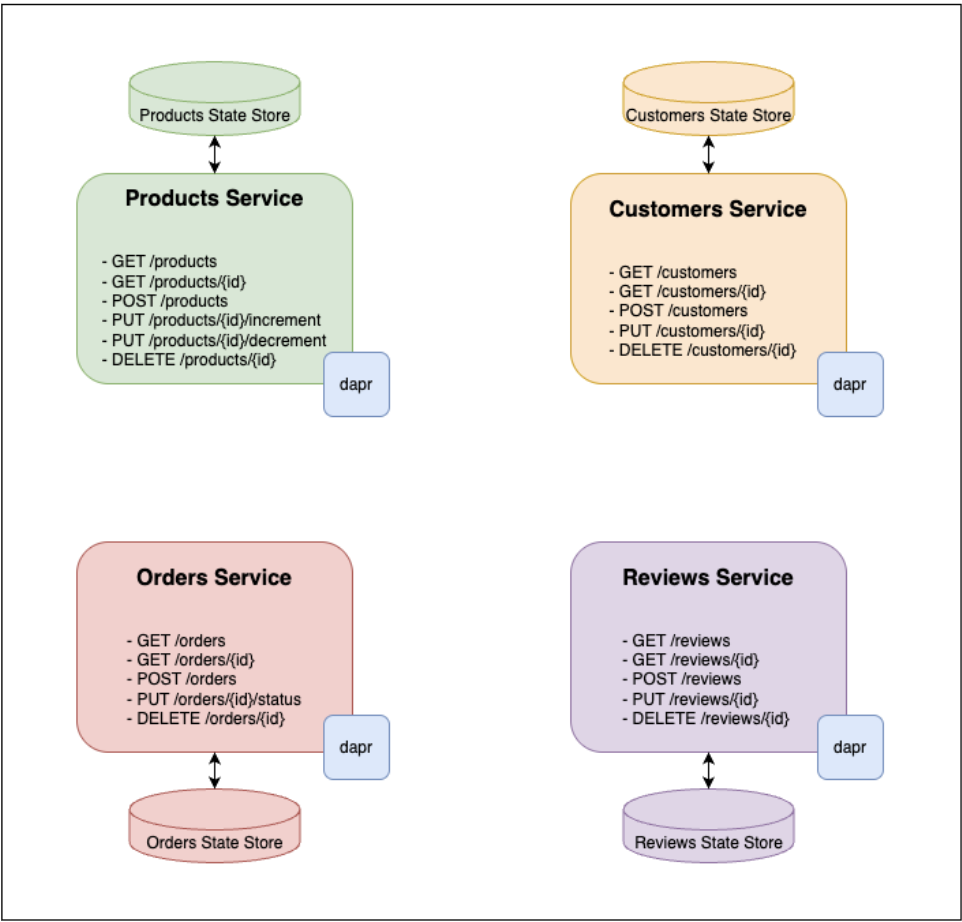
Each service uses Dapr’s state management building block with PostgreSQL as the backing store, following microservices best practices of data isolation.
The Challenges
While Dapr provides excellent building blocks for microservices, certain cross-service scenarios remain challenging:
1. Derived Data Challenge
The marketing team wants a product catalog that combines:
- Product details from the Products Service
- Average ratings and review counts from the Reviews Service
- Real-time stock levels
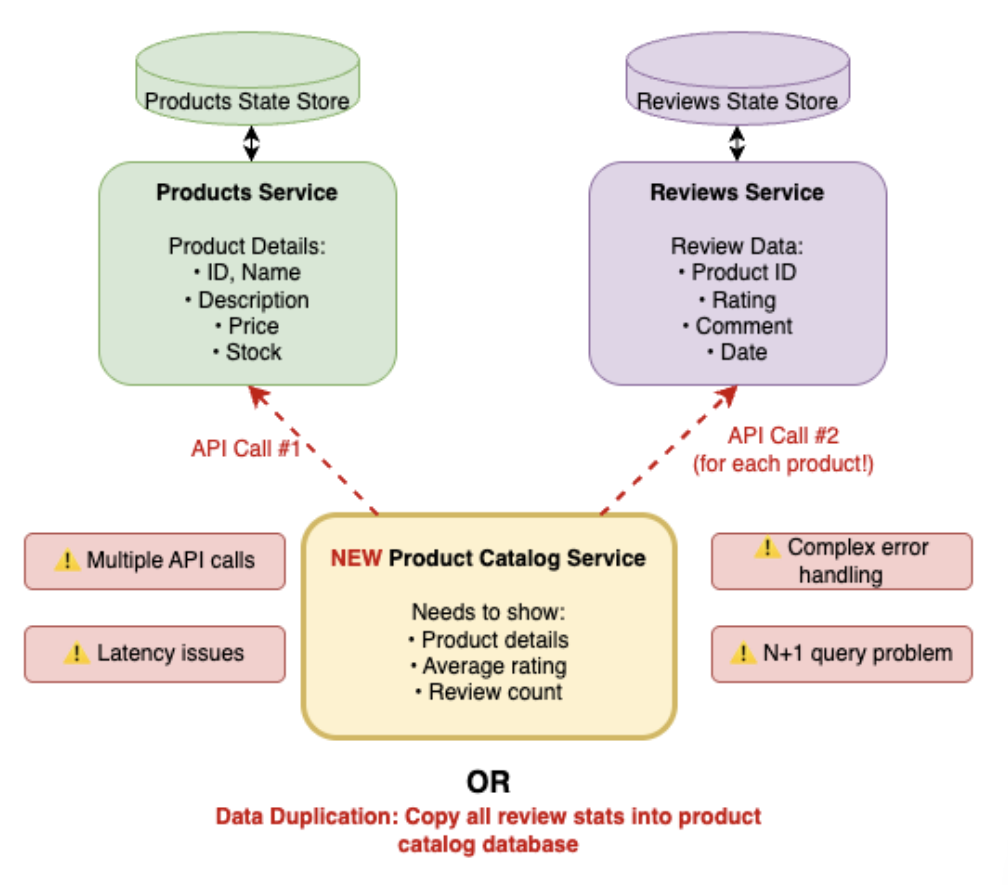
Without Drasi, this would require:
- API orchestration across multiple services
- Caching layers to avoid constant polling
- Complex synchronization logic when data changes
2. Real-Time Monitoring Challenge
The operations team needs dashboards showing:
- Gold customers with delayed orders (say >2 days)
- Orders at risk due to insufficient stock
- Real-time updates as conditions change
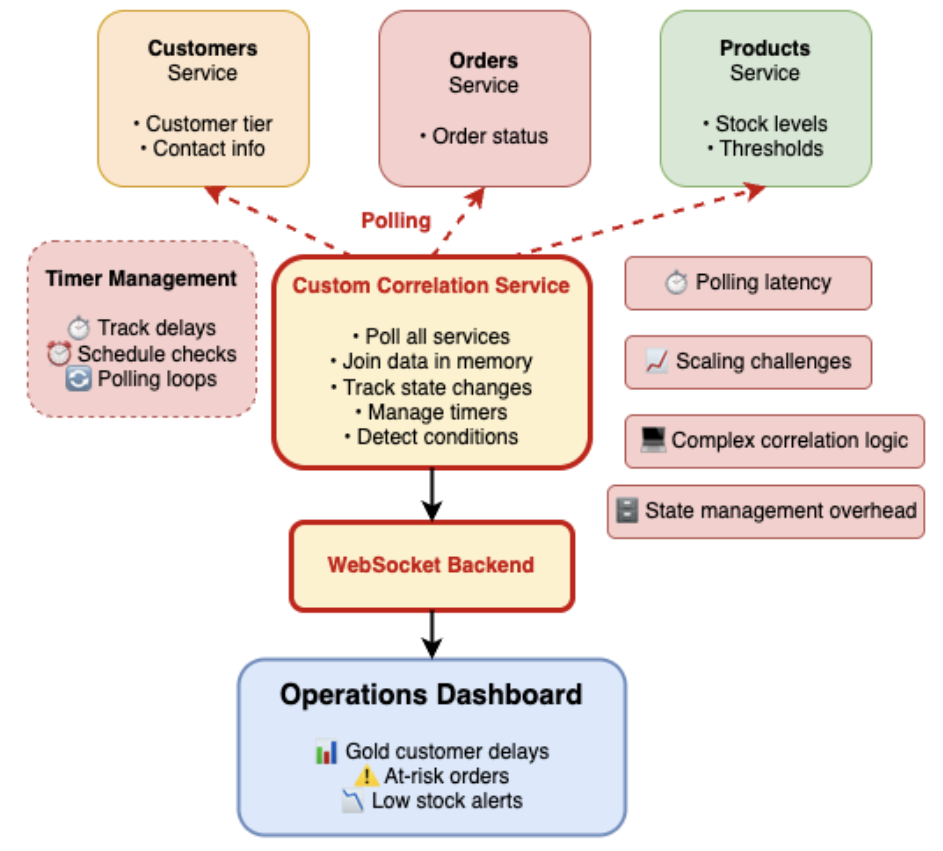
Traditional approaches would involve:
- Periodic polling of multiple services
- Client-side data correlation
- Significant network overhead
3. Intelligent Business Events Challenge
The inventory team needs differentiated alerts:
- Low stock warning when inventory drops below 20 units
- Critical stock alert when inventory drops below 5 units
- Different teams notified based on severity
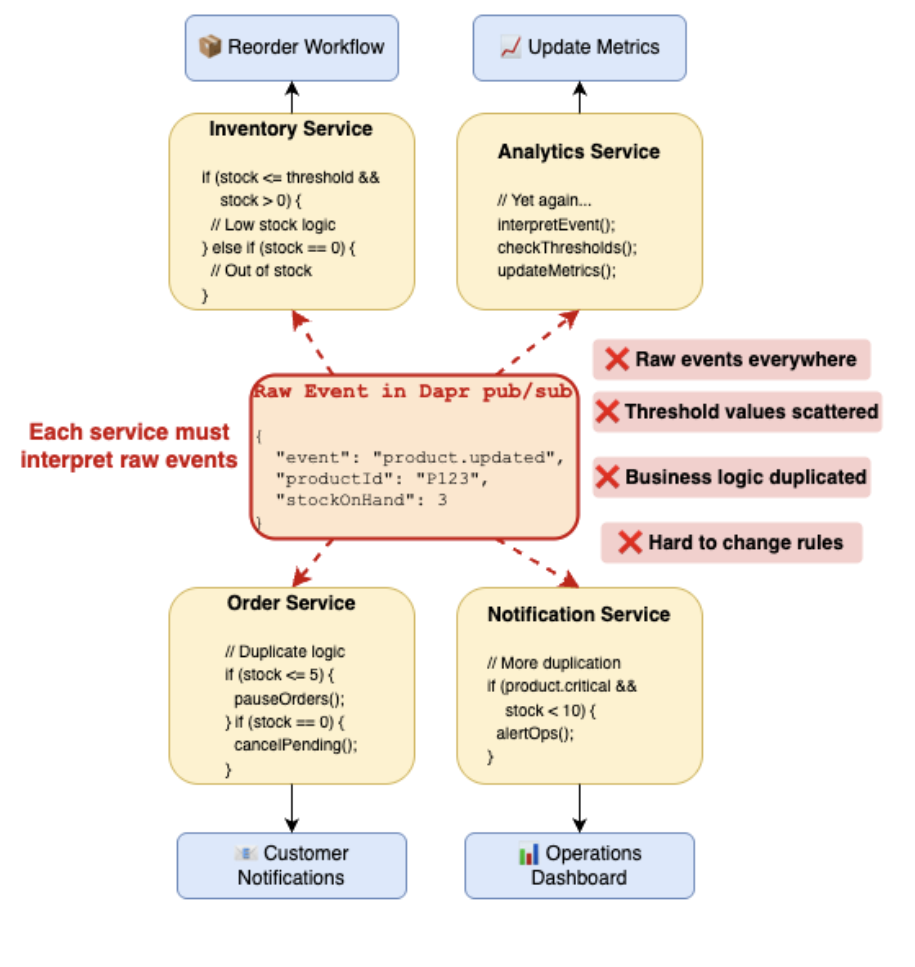
This typically requires:
- Custom event processing logic
- State management for threshold tracking
- Complex pub/sub routing rules
Traditional Approaches
For the derived data scenario, you could decide to use an API Gateway to aggregate data from multiple services. You could also introduce a caching layer to avoid repeatedly querying the underlying services, but the complexity and failure rates remain high.
For all the scenarios, you could use event sourcing with CQRS, where services publish domain events to an event store and build read models on top of that. Then query services can serve aggregated data and event processors handle business logic. This comes with a complete audit trail, but comes with significant architectural changes and require modifications to existing services.
You could also use Change Data Capture with stream processing, but you will need complex infrastructure setup (Kafka, Flink, etc.) and operational overhead. You must also deal with schema evolution changes.
Enter Drasi
What if you could solve these challenges without writing backend code or managing complex infrastructure?
Drasi provides a data change processing platform that:
- Monitors your Dapr state stores via PostgreSQL logical replication
- Processes complex queries across multiple databases in real-time
- Triggers reactions only when meaningful conditions are met
- Requires zero changes to your existing Dapr services
Why Drasi for Dapr Users?
Built on Dapr: Drasi itself runs on Dapr and uses Dapr building blocks internally (Actors, State Stores, Pub/Sub). Installing Drasi automatically installs Dapr if not present.
Non-Invasive Integration: Connects directly to your PostgreSQL state stores without modifying services or adding SDKs.
Declarative Queries: Write Cypher queries to detect complex patterns across services - no imperative code needed.
Native Dapr Reactions: Purpose-built reactions for Dapr ecosystems:
- Sync Dapr State Store for materialized views
- Post Dapr Pub/Sub for event generation
- SignalR for real-time updates
Here’s how our architecture looks with Drasi:

Dapr + Drasi Tutorial
This tutorial will guide you through setting up a complete e-commerce scenario demonstrating Drasi’s capabilities with Dapr applications.
What You’ll Build
- Product Catalog Service: A materialized view combining products and review statistics
- Operations Dashboard: Real-time monitoring of at-risk orders and Gold customer delays
- Notifications Service: Intelligent inventory alerts with business logic
Tutorial Modes
You can follow along in three different environments:
The easiest way to follow this tutorial is using GitHub Codespaces. Everything will be pre-configured in your browser.
This will open a configuration page like shown below. Ensure the following:
- Branch:
main - Dev container configuration:
Drasi For Dapr - Machine type: Prefer 8-core or higher
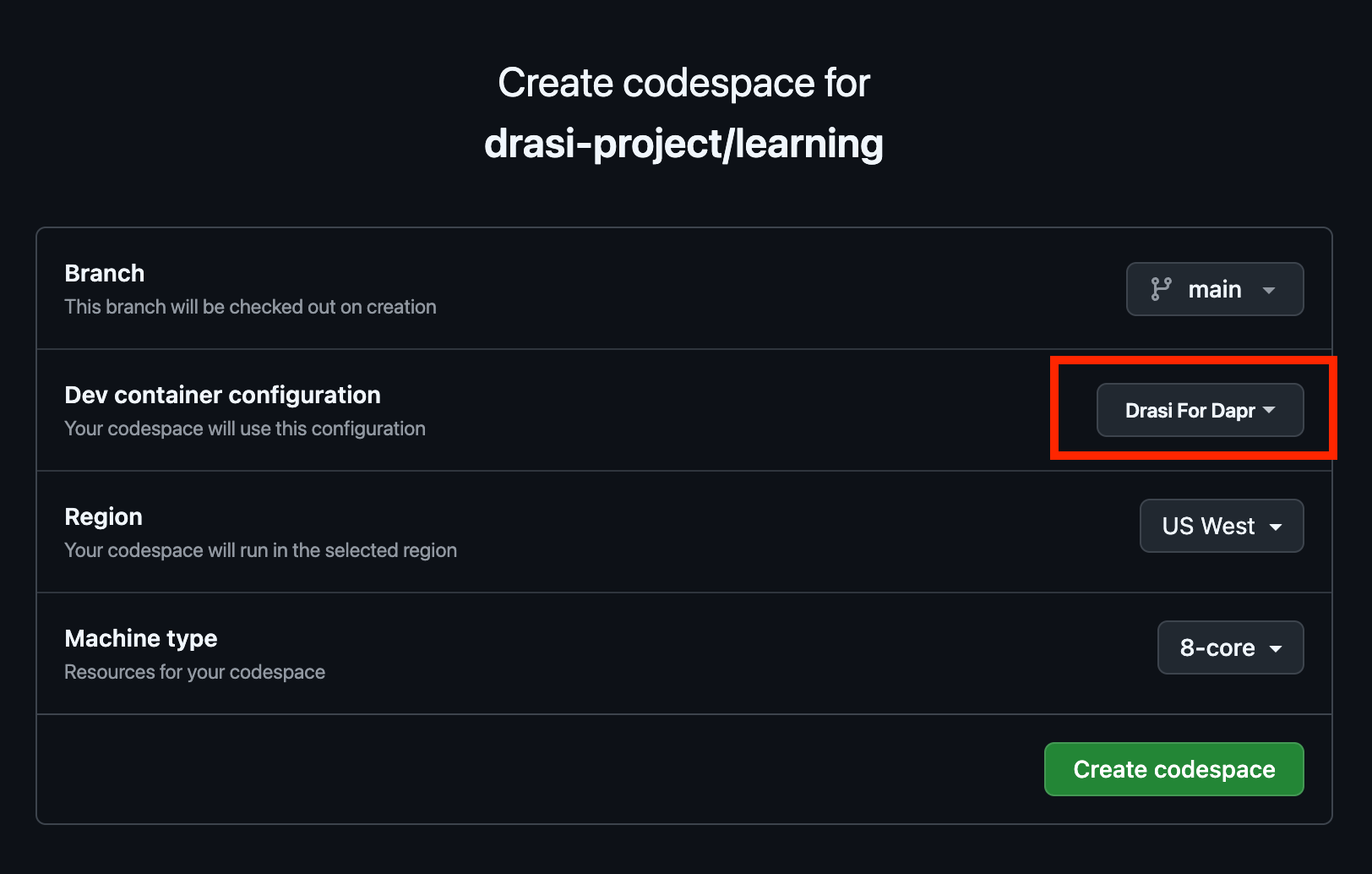
The Codespace will take about 5 minutes to initialize. You’ll see setup logs in the terminal showing:
- K3d cluster creation
- Drasi platform installation (includes Dapr)
- PostgreSQL and Redis deployment
- All microservices deployment
- Load initial data
To use a Dev Container locally, you’ll need:
- Visual Studio Code
- Dev Containers extension
- Docker Desktop
- At least 16GB available RAM
Steps:
- Clone the learning repository
- Open the repository in VS Code
- When prompted, click “Dev Containers: Rebuild and Reopen in Container”
- Select
Drasi for Daprfrom the list - Wait for initialization (~5 minutes)
The Dev Container will automatically:
- Create a k3d cluster
- Install Drasi (includes Dapr)
- Deploy all services
- Load initial data
For local Kubernetes setup, you’ll need:
- Docker
- kubectl
- k3d (or another Kubernetes distribution)
- Drasi CLI
Navigate to the tutorial directory and run the setup script:
cd tutorial/dapr
# For Linux/Mac
./scripts/setup-tutorial.sh
# For Windows PowerShell
./scripts/setup-tutorial.ps1
The script will:
- Create a k3d cluster with port mapping
- Install Drasi platform (includes Dapr)
- Deploy PostgreSQL databases for each service
- Deploy Redis for notifications
- Deploy all Dapr services
- Load initial data
Verify the Setup
Once setup is complete, verify all services are running:
kubectl get svc
You should see:
- 4 core services (products, customers, orders, reviews)
- 3 Drasi-powered services (catalogue, dashboard, notifications)
- PostgreSQL instances for each service
- Redis for notifications
Access the services via the forwarded ports. Check the PORTS tab in VS Code:

Your URLs will be:
- Products API:
https://<codespace-name>-80.app.github.dev/products-service/docs - Customers API:
https://<codespace-name>-80.app.github.dev/customers-service/docs - Orders API:
https://<codespace-name>-80.app.github.dev/orders-service/docs - Reviews API:
https://<codespace-name>-80.app.github.dev/reviews-service/docs
Services are accessible on localhost:8123:
- Products API: http://localhost:8123/products-service/docs
- Customers API: http://localhost:8123/customers-service/docs
- Orders API: http://localhost:8123/orders-service/docs
- Reviews API: http://localhost:8123/reviews-service/docs
Services are accessible on localhost:8123:
- Products API: http://localhost:8123/products-service/docs
- Customers API: http://localhost:8123/customers-service/docs
- Orders API: http://localhost:8123/orders-service/docs
- Reviews API: http://localhost:8123/reviews-service/docs
Deploy Drasi Components
Now let’s deploy the Drasi sources, queries, and reactions that will power our enhanced services:
If you’re following the tutorial in a Codespace or DevContainer, you can use the VSCode Extension available for Drasi as shown here. The Drasi Explorer shows the state of your Drasi clusters, and the Workspace shows the Drasi YAML files detected in the project.
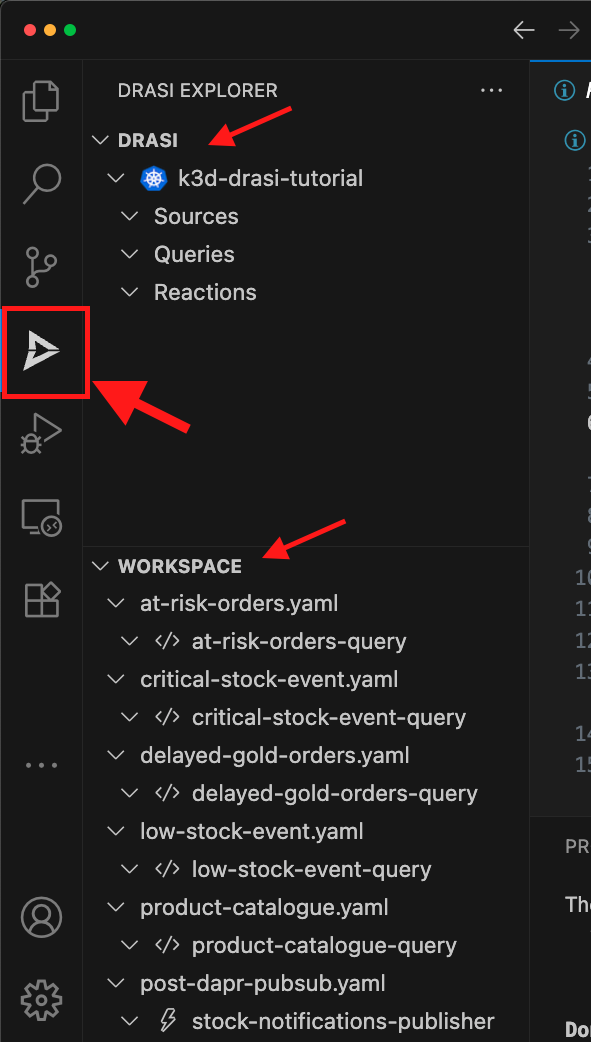
Apply the products-source yaml like from the workspace shown below:
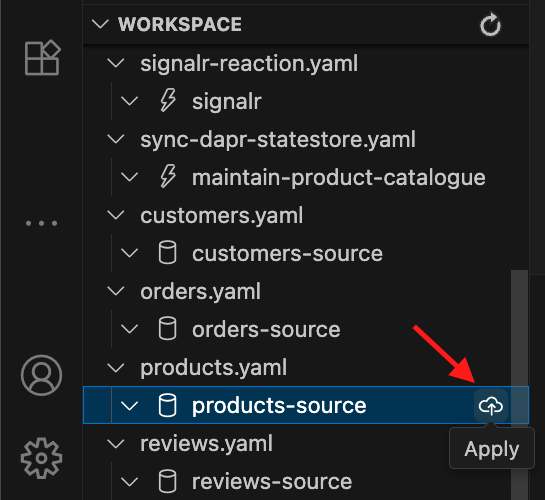
Similarly apply the other three sources - reviews-source, orders-source, customers-source. You should see the sources in Red in the Drasi Explorer as shown here:
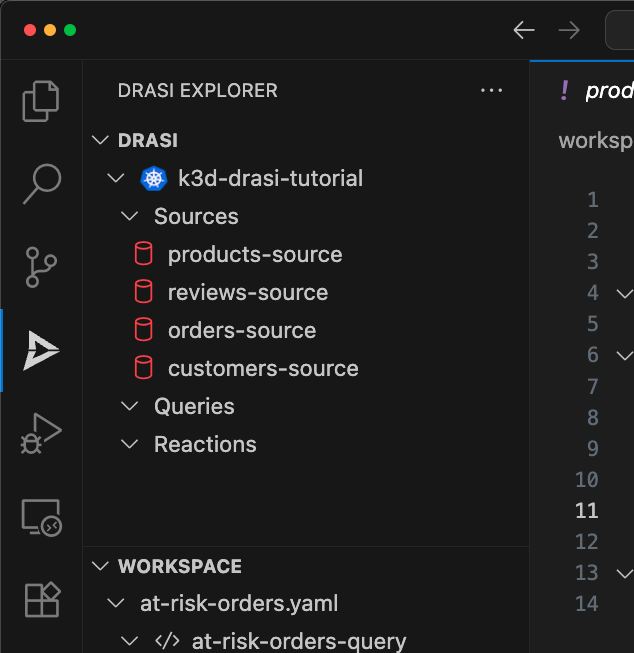
Wait for the sources to become available. They should become available in a couple minutes. If not, try the refresh button on the Drasi Explorer. Once available, all sources will show up as green:

Now, apply all the queries from the workspace one by one:
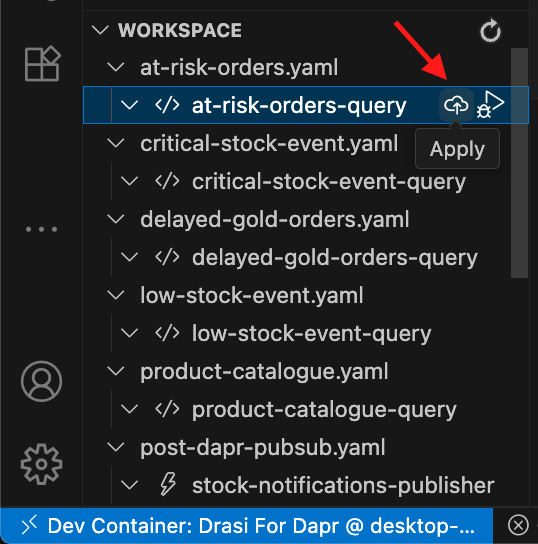
Wait for them to bootstrap and once they’re running, they will show up as green:
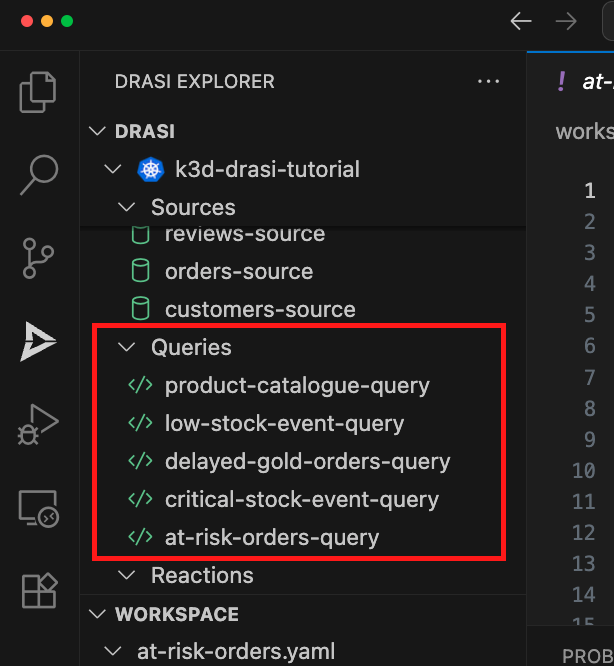
Finally, apply all the reactions from the workspace one by one:
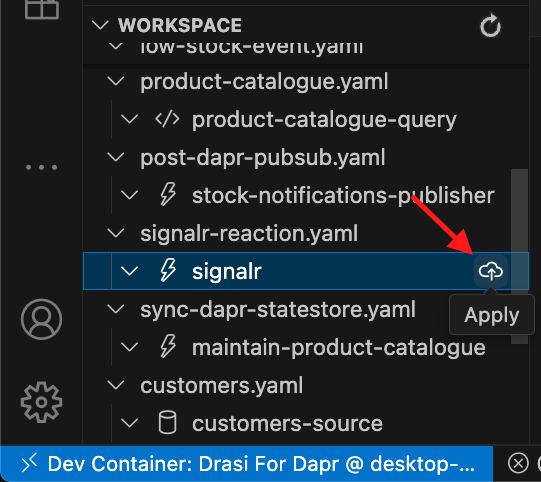
Wait for them to bootstrap and once they’re running, they will show up as green:

Deploy Drasi Sources and wait for them to be live:
drasi apply -f drasi/sources/*
drasi wait -f drasi/sources/*
Verify Drasi sources are ready:
drasi list sources
The source must report `Available` as `true`. Expected output:
ID | AVAILABLE | MESSAGES
-------------------+-----------+-----------
products-source | true |
reviews-source | true |
orders-source | true |
customers-source | true |
Next, deploy Continuous Queries and wait for them to be live:
drasi apply -f drasi/queries/*
drasi wait -f drasi/queries/*
Verify Drasi queries are ready:
drasi list query
The queries must report `Status` as `Running`. Expected output:
ID | CONTAINER | ERRORMESSAGE | HOSTNAME | STATUS
-----------------------------+-----------+--------------+------------------------------------+----------
product-catalogue-query | default | | default-query-host-57c7796d5-fnttx | Running
low-stock-event-query | default | | default-query-host-57c7796d5-fnttx | Running
delayed-gold-orders-query | default | | default-query-host-57c7796d5-fnttx | Running
critical-stock-event-query | default | | default-query-host-57c7796d5-fnttx | Running
at-risk-orders-query | default | | default-query-host-57c7796d5-fnttx | Running
Finally, deploy Reactions and wait for them to be live:
drasi apply -f drasi/reactions/*
drasi wait -f drasi/reactions/*
Verify Drasi queries are ready:
drasi list reaction
The reactions must report `Available` as `true`. Expected output:
ID | AVAILABLE | MESSAGES
--------------------------------+-----------+-----------
stock-notifications-publisher | true |
maintain-product-catalogue | true |
signalr | true |
Demo 1: Materialized State Store
The Product Catalog demonstrates how Drasi can maintain a materialized view combining data from multiple services.
Understanding the Query
Let’s examine the product-catalogue query that powers this feature:
MATCH
(r:reviews)-[:REVIEW_TO_PRODUCT]->(p:products)
WITH
p, avg(r.rating) as avgRating, count(r) as reviewCount
RETURN
p.productId AS product_id,
p.productName AS product_name,
p.productDescription AS product_description,
avgRating AS avg_rating,
reviewCount AS review_count
This query:
- Matches all products
- Joins with reviews for each product
- Calculates review statistics
- Returns a complete catalog entry
The Sync Dapr State Store Reaction
The reaction configuration syncs query results to a new Dapr state store:
apiVersion: v1
kind: ConfigMap
metadata:
name: sync-dapr-statestore
data:
query: product-catalogue
daprStateStoreName: catalogue-statestore-drasi
daprAppId: drasi-reaction
See It In Action
-
Open the Catalog UI:
https://<codespace-name>-80.app.github.dev/catalogue-service -
Note the products display with review statistics
-
In a new terminal, run the demo script:
cd demo ./demo-catalogue-service.sh
-
Open the Catalog UI:
http://localhost:8123/catalogue-service -
Note the products display with review statistics
-
In a new terminal, run the demo script:
cd demo ./demo-catalogue-service.sh
-
Open the Catalog UI:
http://localhost:8123/catalogue-service -
Note the products display with review statistics
-
In a new terminal, run the demo script:
cd demo ./demo-catalogue-service.sh
The demo will:
- Show current catalog state
- Add new reviews to products
- Demonstrate real-time catalog updates
- Modify product prices
- Show immediate reflection in the UI
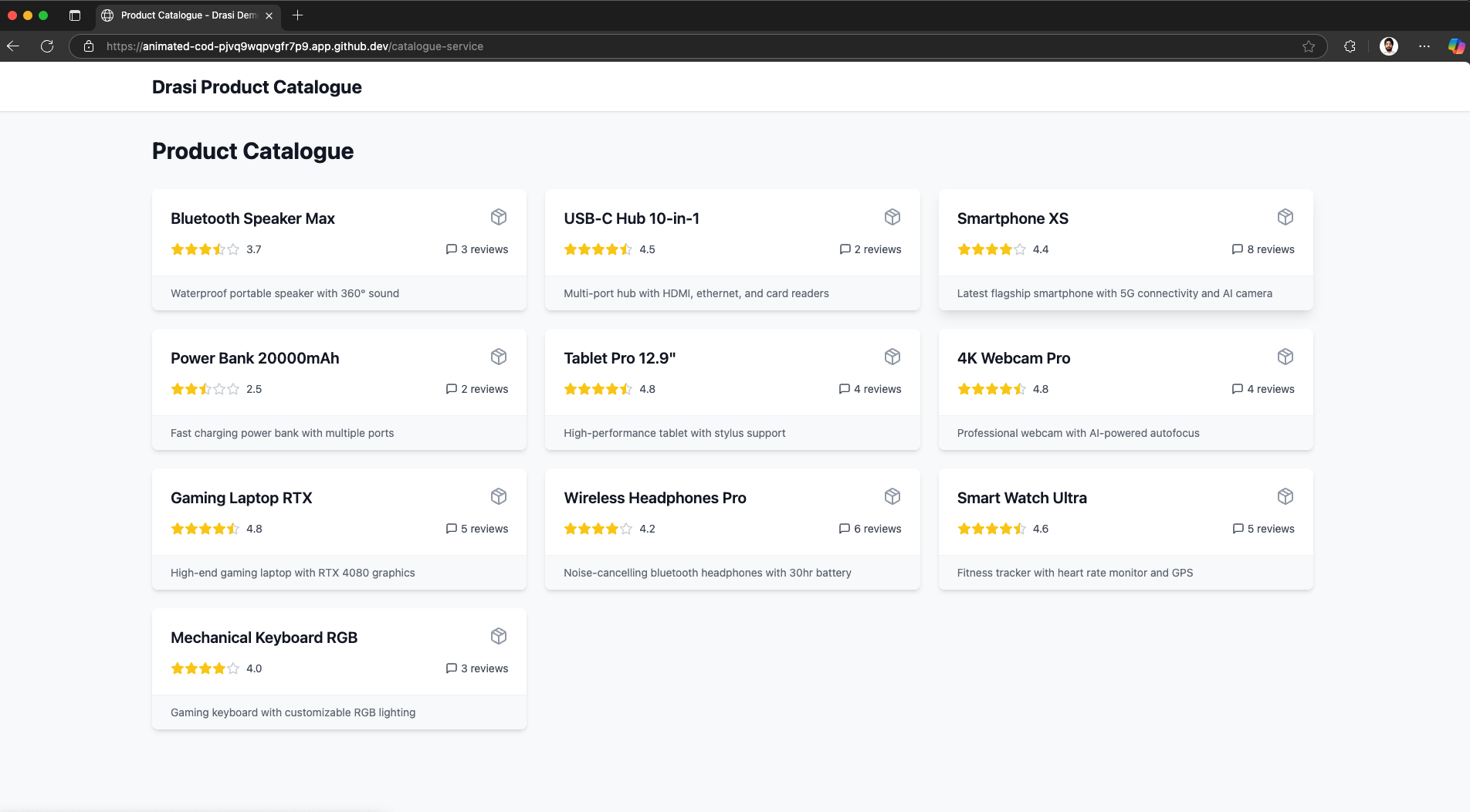
Key observations:
- No API calls between services
- No polling for updates
- Immediate consistency when data changes
- Zero code for aggregation logic
Demo 2: Real-Time Dashboard
The dashboard demonstrates complex monitoring queries across multiple services.
Query 1: At-Risk Orders
MATCH
(o:orders)-[:ITEM_OF_ORDER]->(oi:orderItem),
(oi)-[:ORDER_ITEM_TO_PRODUCT]->(p:products)
WHERE
o.orderStatus IN ['PENDING', 'PAID'] AND
p.stockOnHand < oi.quantity
RETURN
o.orderId AS orderId,
o.customerId AS customerId,
o.orderStatus AS orderStatus,
oi.quantity AS quantity,
p.productId AS productId,
p.productName AS productName,
p.stockOnHand AS stockOnHand
This query identifies orders that are in PENDING or PAID state, but cannot be fulfilled due to stock shortages.
Query 2: Delayed Gold Orders
MATCH
(o:orders)-[:ORDER_TO_CUSTOMER]->(c:customers)
WHERE
c.loyaltyTier = 'GOLD'
WITH
o, c, drasi.changeDateTime(o) as waitingSince
WHERE
drasi.trueFor(o.orderStatus = 'PROCESSING', duration ({ seconds: 10 }))
RETURN
o.orderId AS orderId,
o.orderStatus AS orderStatus,
c.customerId AS customerId,
c.customerName AS customerName,
c.customerEmail AS customerEmail,
waitingSince
This detects orders from Gold customers that are stuck in PROCESSING state for more than 10 seconds. Of course, in the real world we can change this to be days or any arbitrary time interval.
But this query highlights the unique ability of Drasi to monitor not just for changes, but also for absence of changes. Here we are using trueFor - which is one of Drasi’s many future functions.
SignalR Reaction
The SignalR reaction streams query results in real-time:
apiVersion: v1
kind: Reaction
name: signalr
spec:
kind: SignalR
queries:
at-risk-orders-query:
delayed-gold-orders-query:
When you apply this simple YAML file to Drasi, it will deploy a new reaction which is a full fledged web-socket server that is based on SignalR (and therefore gets the websocket fallback mechanisms from SignalR like SSE, etc.).
Drasi also frontend components for React and Vue published to NPM, which makes it really easy to build reactive front-end dashboards that display the live result set of Drasi’s continuous queries.
See It In Action
We’ve written an interactive demo script for you to see the dashboard live in action.
-
Open the Dashboard:
https://<codespace-name>-80.app.github.dev/dashboard -
Run the demo script:
cd demo ./demo-dashboard-service.sh
-
Open the Dashboard:
http://localhost:8123/dashboard -
Run the demo script:
cd demo ./demo-dashboard-service.sh
-
Open the Dashboard:
http://localhost:8123/dashboard -
Run the demo script:
cd demo ./demo-dashboard-service.sh
The demo will:
- Create orders for Gold customers
- Show real-time dashboard updates
- Simulate order delays
- Reduce product stock
- Display at-risk orders immediately
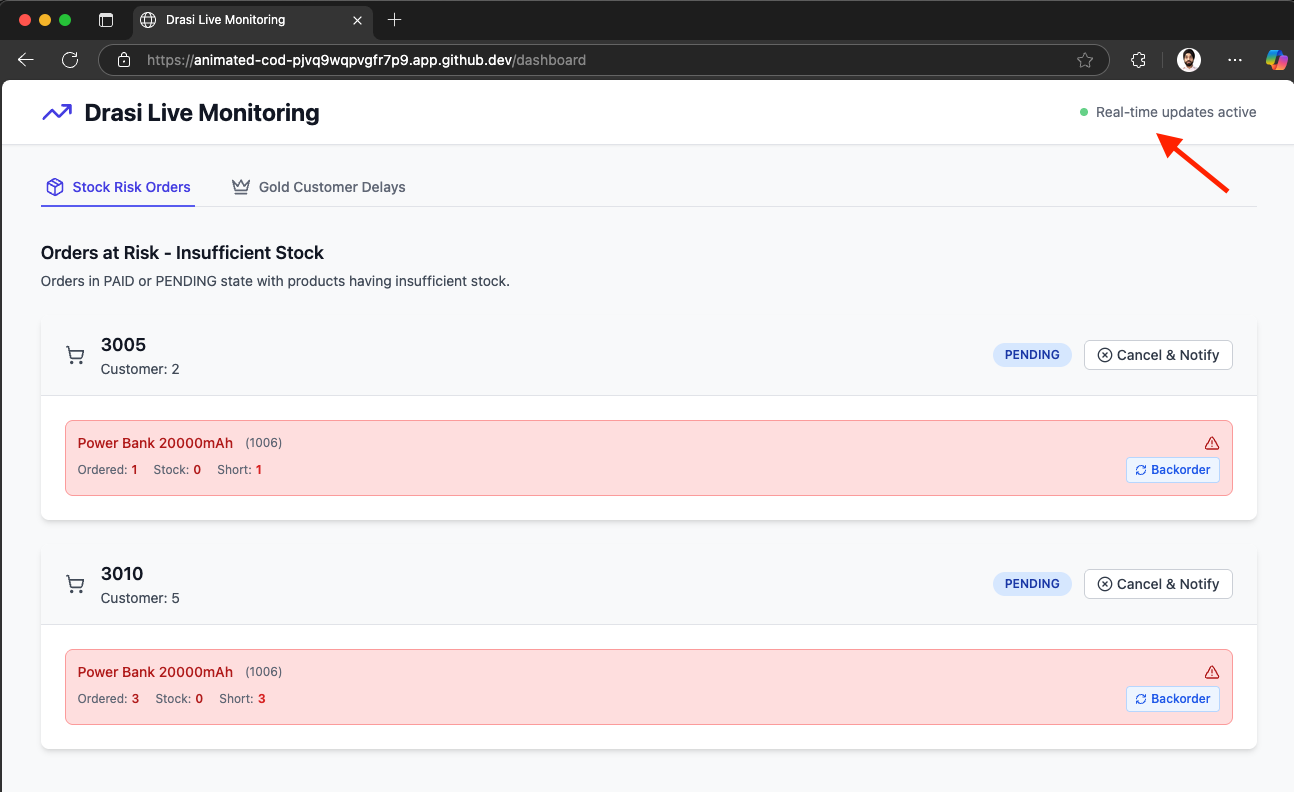
Watch for:
- WebSocket connections established automatically
- Instant updates when conditions are met
- Automatic removal when conditions no longer apply
- Cross-service correlations without API calls
Demo 3: Intelligent Notifications
The notifications service demonstrates event transformation and intelligent routing. Let’s consider the two queries that give us actionable business events instead of raw change-events.
Low Stock Event Query
Following query maintains the list of products for which the stock is below threshold but is still not zero:
MATCH
(p:products)
WHERE
p.stockOnHand <= p.lowStockThreshold AND p.stockOnHand > 0
RETURN
p.productId AS productId,
p.productName AS productName,
p.stockOnHand AS stockOnHand,
p.lowStockThreshold AS lowStockThreshold
Critical Stock Event Query
Following query maintains the list of products for which the stock is completely exhausted:
MATCH
(p:products)
WHERE
p.stockOnHand = 0
RETURN
p.productId AS productId,
p.productName AS productName,
p.productDescription AS productDescription
Post Dapr Pub/Sub Reaction
With the following YAML file, we can tell Drasi on how to route the business events to a dapr pub-sub. Here we can control what topic to route events to, their format and other settings. More details on how to setup a Post-Dapr-PubSub Reaction in Drasi are here.
kind: Reaction
apiVersion: v1
name: stock-notifications-publisher
spec:
kind: PostDaprPubSub
queries:
# Publish low stock events to the "low-stock-events" topic
low-stock-event-query: >
{
"pubsubName": "notifications-pubsub",
"topicName": "low-stock-events",
"format": "Unpacked",
"skipControlSignals": true
}
# Publish critical stock events to the "critical-stock-events" topic
critical-stock-event-query: >
{
"pubsubName": "notifications-pubsub",
"topicName": "critical-stock-events",
"format": "Unpacked",
"skipControlSignals": true
}
See It In Action
-
Open the Notifications UI:
https://<codespace-name>-80.app.github.dev/notifications-service -
Run the demo script:
cd demo ./demo-notifications-service.sh
-
Open the Notifications UI:
http://localhost:8123/notifications-service -
Run the demo script:
cd demo ./demo-notifications-service.sh
-
Open the Notifications UI:
http://localhost:8123/notifications-service -
Run the demo script:
cd demo ./demo-notifications-service.sh
The demo will:
- Show current inventory levels
- Gradually reduce stock levels
- Trigger low stock warnings at <20 units
- Escalate to critical alerts at <5 units
- Demonstrate different notification routing
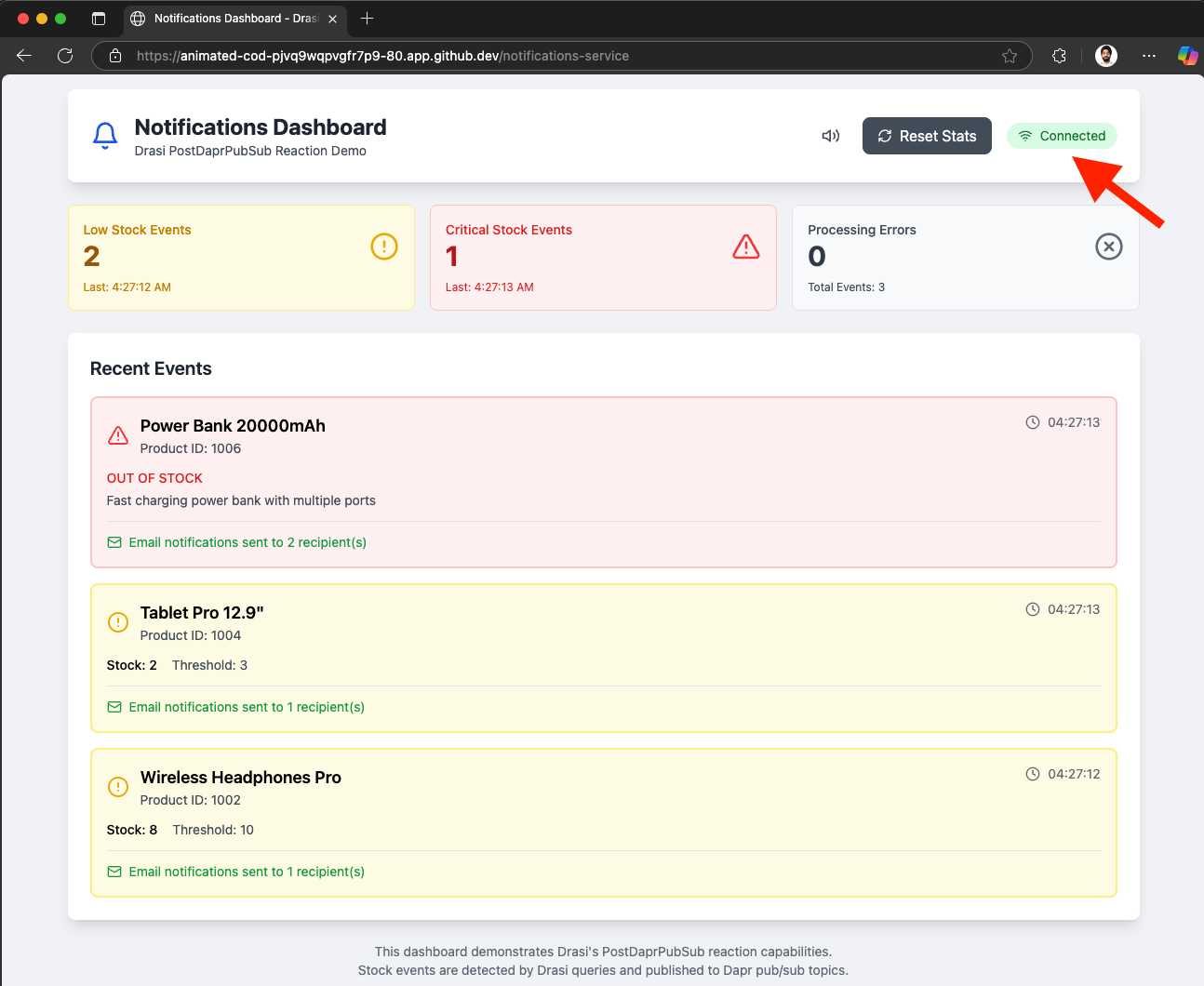
Observe:
- Event transformation from database changes
- Business logic in declarative queries
- Differentiated routing based on severity
- No custom event processing code
Cleanup
To remove all resources:
Simply delete the Codespace from your GitHub account.
- Stop the Dev Container (File → Close Remote Connection)
- Optional: Remove the container via Docker Desktop
Run the cleanup script, to delete the k3d cluster:
cd tutorial/dapr
# Linux/Mac
./scripts/cleanup-tutorial.sh
# Windows PowerShell
./scripts/cleanup-tutorial.ps1
Summary
In this tutorial, you’ve seen how Drasi enhances Dapr applications by:
- Eliminating Integration Code: No API orchestration or polling logic needed
- Providing Real-Time Updates: Changes detected and propagated instantly
- Enabling Complex Queries: Cross-service patterns detected declaratively
- Maintaining Data Isolation: Services remain independent and decoupled
- Reducing Operational Complexity: No additional infrastructure to manage
Key Takeaways
For Dapr Developers:
- Keep your services simple and focused
- Let Drasi handle cross-service concerns
- Use declarative queries instead of imperative code
- Leverage Dapr building blocks through Drasi reactions
For Architects:
- Maintain microservices best practices
- Add real-time capabilities without architectural changes
- Scale monitoring and analytics independently
- Reduce operational overhead
For Operations:
- Monitor complex conditions across services
- Get alerts based on business logic, not just metrics
- Reduce database load from polling
- Simplify troubleshooting with declarative queries
More
- Explore More Tutorials: Learn by doing with Drasi in various scenarios here.
- Drasi Documentation: https://drasi.io
- Dapr Documentation: https://docs.dapr.io
- GitHub Repository: https://github.com/drasi-project
- Dapr Community Call Recording: Watch on YouTube
Feedback
Was this page helpful?
Glad to hear it! Please tell us what you found helpful.
Sorry to hear that. Please tell us how we can improve.